Ang mga insulator nga gihimo sa porcelana ug lawas nga giputli nagsilbi og maayo nga pagkumpol ug pwersa mekanikal, apan mahimong madagan sa flashover tungod sa kalambigitan sa dili magpuno, nagbabanta sa establisadong operasyon sa power grid. Aron mapataas ang resistensya sa flashover sa kalambigitan, ang mga manugprodyukto kasagaran mopangita og RTV (room-temperature vulcanized) nga coating sa ibabaw sa insulator, na may higayon nga hydrophobic ug properties sa transfer sa hydrophobicity, aron mapababa ang panganak nga flashover. Sa unang bahin, ang mga coating sa RTV sa Tsina gipangaplay sa lugar, usa ka estilo nga karakterisado sa mataas nga kahadlok sa pagbukid ug inconsistent nga kontrol sa kalidad.
Pagkatapos, ang proseso sa pagdip o pag-spray sa factory gibuo, naghatag og oportunidad sa mga RTV-coated insulators nga mailhan isip kompleto nga produkto sa dihang gi-supervise ug gi-accept, na resulta sa sigurado nga pagtaas sa kalidad sa produkto ug nagpadayon sa maluwas nga paggamit sa power grids. Apan, ang mga coating sa RTV adunay gamay nga pwersa mekanikal ug dili matigayong interfacial adhesion sa insulating body, mao kini masusugdan sa pinsala gikan sa eksternal nga pwersa sa panahon sa transport, pagbuhat, pag-install, ug long-term nga operasyon. Ang mga aging phenomena sama sa peeling, cracking, ug delamination kasagaran, nagresulta sa disassembly ug pag-recoat, nagresulta sa mataas nga maintenance cost.
Ang disc suspension composite porcelain insulators gigamit og kompletong porcelain insulator isip core, uban sa HTV (high-temperature vulcanized) silicone rubber sheath—minimum thickness of 3 mm—gibuo sa single molding proseso pinaagi sa high-temperature injection. Kumpara sa RTV, ang HTV nagsulbar og mas maayo nga pwersa mekanikal, samtang mas maayo usab ang performance sa tracking ug erosion resistance, flame retardancy, electrical properties, aging resistance, ug high-temperature endurance.
Basaha pa, ang pag-modify sa glaze layer sa ibabaw sa porcelain ug paggamit og specialized coupling agents, nagresulta sa significant improvement sa interfacial bonding strength tali sa porcelain ug HTV silicone rubber, nagpromote sa integration ug uniformity sa component. Taliwala niini, ang disc suspension composite porcelain insulators naghatag og superior mechanical ug anti-pollution flashover performance uban sa gamay nga operational ug maintenance requirements, nagbukas og bag-ong ruta para sa external insulation applications sa transmission lines.
Ang field experience nagpakita nga kapag nahitabo ang lightning strike sa overhead lines, ang resulta nga overvoltage naglakip og steep-fronted impulses nga may napuno nga duration, mataas nga steepness, ug labi ka taas nga peak voltages, nagbabanta sa line insulators. Ang mga steep impulses makapadagan sa puncture o explosion sa disc insulators, ug sa severe cases, mahimong makapadaog sa string breakage ug line drop. Ang capability sa steep-front impulse usa ka critical indicator sa kalidad sa insulator.
Bagama may daghan na nga ginastudiar ang steep-wave performance sa porcelain ug glass insulators both domestically ug internationally, ang studies sa disc suspension composite porcelain insulators wala pa mobati, ug ang ilang underlying mechanisms wala pa mobati. Dili kini, ang paper nga gi-conduct ang impulse breakdown tests in air sa disc suspension composite porcelain insulators aron mapagtambal ang ilang steep-wave breakdown characteristics.
Ang air impulse breakdown tests effective nga ebaluha ang steep-wave withstand performance sa electrical equipment, ensuring safety ug reliability sa extreme conditions, ug importante kaayo sa assessment sa kalidad sa insulator. Ang study nga gi-unang perform ang impulse breakdown tests aron mapagtambal ang steep-wave performance, pagkatapos gibuo ang electric field distribution simulation sa peak sa steep-wave voltage batasan sa test results aron mapatun-an ang mechanism sa variation sa performance, nag-aim sa paghatag og guidance para sa insulation coordination sa composite porcelain insulators sa transmission lines.
1 Air Impulse Breakdown Test Setup
1.1 Specimen
Ang HU550B240/650T AC disc suspension composite porcelain insulator giproduktahan sa usa ka manufacturer gipili isip specimen sa test. Ang insulator adunay triple-umbrella structure, as shown in Figure 1. Ang iyang main performance parameters nakalistahan sa Table 1.
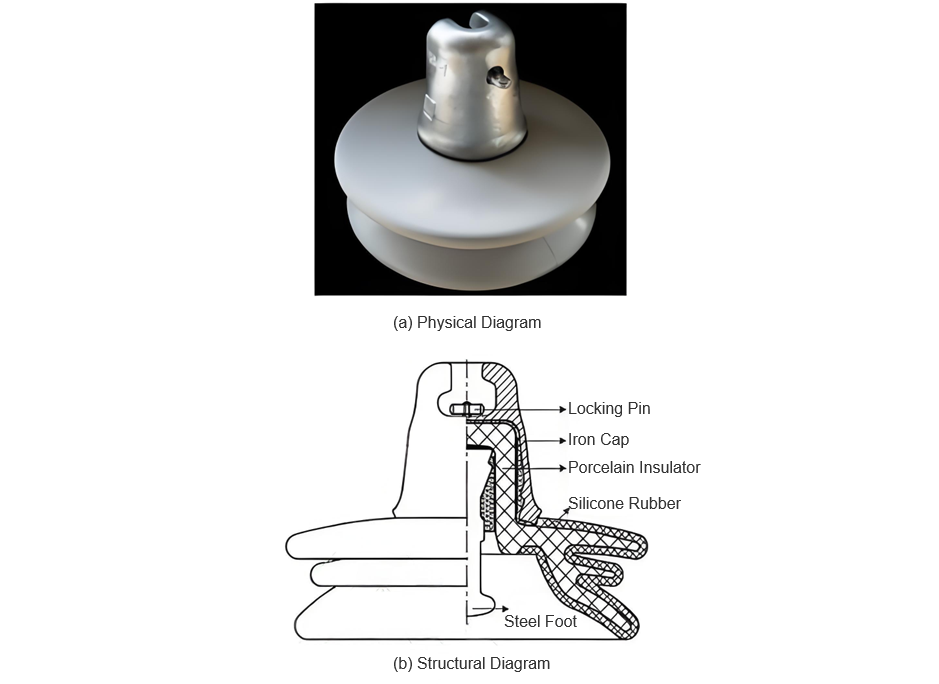

1.2 Test Platform and Scheme
Gigamit ang 2400 kV impulse voltage generator alang sa test. Ang cap sa insulator gihatag sa downward position sa usa ka grounded metal plate, ug ang standard ball socket gipasabot sa pin end aron maprevent ang excessive electric field concentration sa cemented area sa palibot sa pin. Ang setup sa insulator makita sa Figure 2.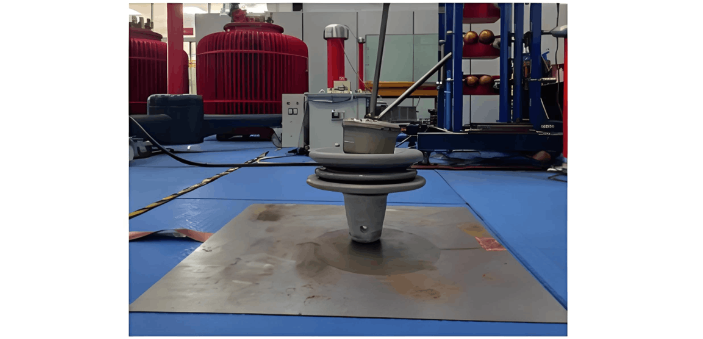
Nagconducted ang air impulse breakdown tests sa total nga 20 specimens sa insulator. Ang mga metodos sa test para sa air impulse breakdown gi-classify isip steepness method ug amplitude method, ang amplitude method primary nga gigamit alang sa disc insulators.
Ang study nga gi-employ ang amplitude method, wala magkinahanglan og linear nga impulse front apan nagamit lamang ang amplitude sa breakdown voltage isip criteria, ang front time controlled between 100 ug 200 ns ug ang amplitude deviation within ±10%. Sa panahon sa test, ang bawg insulator gipasabot og lima ka positive-polarity impulse voltages sumala sa lima ka negative-polarity impulses, ug ang sequence girepeat bisan unsa. Ang interval sa consecutive impulses gipan-maintain between 1 ug 2 minutes.
Ang research gikan sa domestic ug international sources nagpakita nga ang pag-coat sa surface sa insulator ngadto sa silicone rubber nag-alter sa propagation rate sa surface streamers sa porcelain insulators, nagresulta sa reduced steep-front impulse withstand performance. Apan, ang insulation performance sa ulo sa insulator wala mobati sa actual operation.
Kini nga phenomenon confirmed by more than ten domestic disc insulator manufacturers: regardless of whether the shed profile is deep-rib or alternating-umbrella type, or whether the head structure is cylindrical or conical, all insulators exhibit some degree of reduced steep-wave breakdown performance after silicone rubber coating.
As a result, relevant standards have been revised, reducing the impulse breakdown test amplitude in air for RTV-coated disc insulators from 2.8 p.u. to 2.2 p.u. Preliminary test results show that breakdown rarely occurs at 2.2 p.u. Therefore, this study selected porcelain insulators without RTV coating and conducted air impulse breakdown tests at the standard test voltage of 2.8 p.u., with the voltage front time controlled within the 100–200 ns range.

Further statistical analysis of the voltage polarity and breakdown location revealed that out of 15 breakdown events, 14 occurred under positive polarity and only one under negative polarity. Among the positive-polarity breakdowns, 8 occurred at the head and 6 at the sheds; the single negative-polarity breakdown occurred at the head. Additionally, arcing was observed on the insulator surface prior to shed breakdowns, whereas no such arcing was observed during head breakdowns.
However, in reference, all steep-front breakdowns of porcelain insulators occurred at the head, and in reference, porcelain insulators broke down at the head both before and after RTV coating. In contrast, this test shows that without the one-time injection-molded HTV overcoat, steep-wave breakdowns in the same batch of porcelain insulators occurred exclusively at the head. After HTV overmolding, breakdowns in the composite porcelain insulators occurred not only at the head but also at the neck, indicating that the HTV silicone rubber coating alters the breakdown path.
The number of impulse applications before breakdown was recorded, with results shown in Figure 4. As illustrated, 12 insulators broke down within the first five impulses, one broke down on the 7th impulse, and two broke down on the 15th impulse. Reference indicates that porcelain insulators coated with RTV exhibit a significant reduction in steep-wave withstand performance, with higher breakdown probability for larger-tonnage insulators, suggesting that silicone rubber coating degrades steep-wave resistance. In this test, 80% of the HTV overmolded composite insulators broke down within the first four impulses, further demonstrating that the presence of HTV silicone rubber significantly reduces the insulator's ability to withstand steep-front impulses.
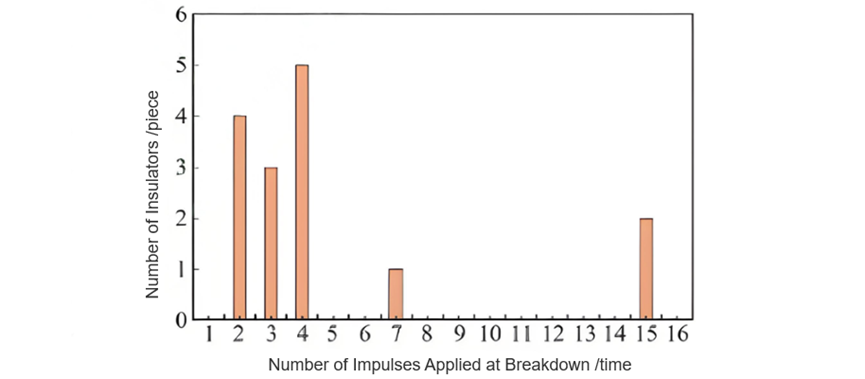
3 Electric Field Distribution Simulation at Steep-Wave Voltage Peak
Analysis of the test results in Section 2 reveals that, compared to porcelain insulators, the breakdown path of composite insulators has changed and their steep-wave withstand performance has significantly decreased. This section employs simulation to calculate the electric field distribution of the composite insulator at the peak of the impulse voltage, aiming to investigate the causes of the altered breakdown path and reduced steep-wave performance.
2.1 Simulation Model
Observations from the air impulse breakdown tests indicate that when shed flashover occurs in composite insulators, arcs develop along the insulator surface to the breakdown location. The presence of arcs influences the electric field distribution and must be considered in the model. However, due to the irregular shape of arcs, establishing a 3D model for computation would be challenging, especially because the silicone rubber layer is thin and much smaller in dimension compared to the overall insulator, making 3D meshing difficult. Therefore, to qualitatively analyze the impact of the silicone rubber layer and arcs on the electric field distribution, a two-dimensional axisymmetric model is adopted for simplification in this section. The simulation model is shown in Figure 5.
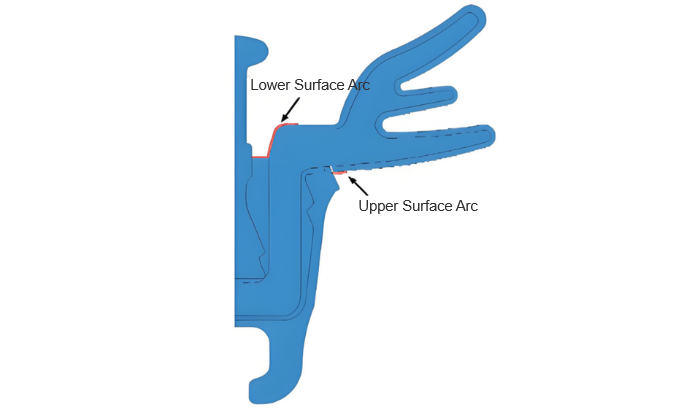
2.2 Materials and Boundary Conditions
The 50% lightning impulse flashover voltage of the insulator is 145 kV, and the peak value of the 2.8 p.u. steep-front impulse voltage is 406 kV. Since most of the test specimens experienced positive-polarity breakdown, in the simulation, the pin (steel pin) is set as the high potential (406 kV) and the cap (steel cap) as zero potential. The relative permittivity values of the materials are listed in Table 2.

2.3 Simulation Results and Analysis
In the model without a silicone rubber coating, the electric field distribution of the porcelain insulator at the peak of the steep-front impulse voltage is shown in Figure 6(a). As seen in Figure 6, the electric field intensity is mainly concentrated at the insulator's head, reaching up to 50 kV/mm, indicating a high likelihood of head flashover—consistent with field experience and related studies.
To comparatively analyze the effect of the silicone rubber coating, the electric field distribution of the composite insulator model with one-time injection-molded silicone rubber was calculated, with results shown in Figure 6(b). It can be observed from Figure 6(b) that the maximum electric field occurs at the end of the arc on the lower surface of the insulating body, approximately 219.4 kV/mm; the field strength at the arc end on the upper surface is lower, at 41.21 kV/mm; and significant field concentration also exists at the pin head, with a maximum of 50.68 kV/mm.
Thus, under the influence of the silicone rubber coating, the surface resistivity of the insulator increases, significantly raising the ratio of volume capacitive current to surface resistive current in the sheds. This leads to a substantial increase in the electric field component perpendicular to the insulator surface, causing the arc to closely follow the surface after initiation.
Under the influence of the HTV coating, surface arcs propagate along the insulator surface when subjected to steep-front voltage, resulting in a sharp rise in local field strength—far exceeding that at the pin head—making breakdown more likely at the arc tip and leading to shed flashover. This indicates that the steep-wave withstand performance is affected by the HTV coating on the shed surface. Additionally, the simulation shows a relatively high electric field at the insulator head, which correlates with the observed head flashovers in tests.
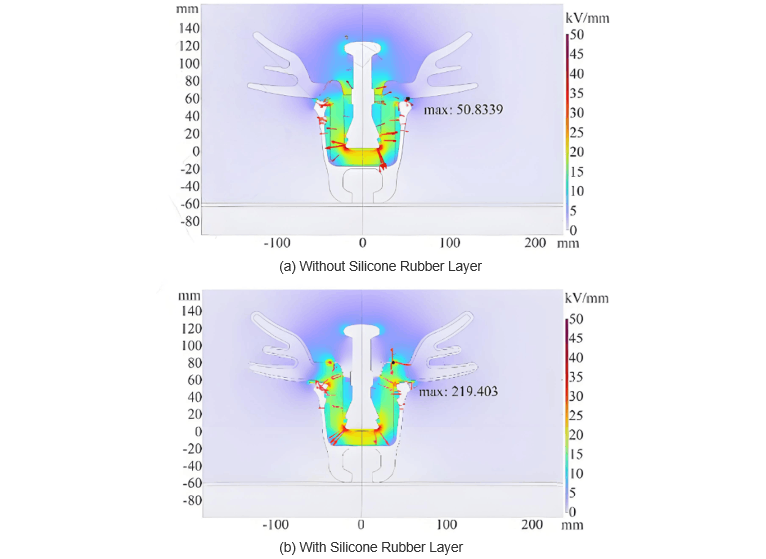
3 Conclusion
Air impulse breakdown tests were conducted on composite insulators to analyze their steep-wave breakdown characteristics, and electric field distribution simulations were performed at the peak of the steep-front voltage. The following conclusions were drawn:
Under 2.8 p.u. steep-front impulse voltage, 15 out of 20 composite insulator specimens experienced breakdown, with 80% occurring within the first four impulses, indicating that the presence of HTV silicone rubber significantly reduces the steep-wave withstand performance of composite insulators.
Among the 15 breakdown events, in addition to flashovers at the pin head, six occurred at the sheds, indicating a clear change in the overall breakdown path compared to conventional porcelain insulators.
Simulation results show that the surface arc propagation in composite insulators causes a significant increase in shed electric field intensity at the voltage peak, reaching 217.64 kV/mm, making shed flashover more likely. In contrast, for insulators without a silicone rubber layer, the maximum field during arc development is located at the pin head, reaching 49.55 kV/mm, where breakdown primarily occurs.





























